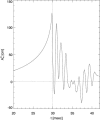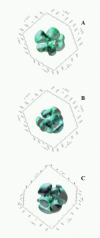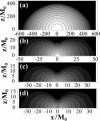Gravitational Waves from Gravitational Collapse
- PMID: 28163639
- PMCID: PMC5253977
- DOI: 10.12942/lrr-2003-2
Gravitational Waves from Gravitational Collapse
Abstract
Gravitational wave emission from stellar collapse has been studied for more than three decades. Current state-of-the-art numerical investigations of collapse include those that use progenitors with more realistic angular momentum profiles, properly treat microphysics issues, account for general relativity, and examine non-axisymmetric effects in three dimensions. Such simulations predict that gravitational waves from various phenomena associated with gravitational collapse could be detectable with ground-based and space-based interferometric observatories. This review covers the entire range of stellar collapse sources of gravitational waves: from the accretion induced collapse of a white dwarf through the collapse down to neutron stars or black holes of massive stars to the collapse of supermassive stars.
Electronic supplementary material: Supplementary material is available for this article at 10.12942/lrr-2003-2.
Figures



















Similar articles
-
Gravitational Waves from Gravitational Collapse.Living Rev Relativ. 2011;14(1):1. doi: 10.12942/lrr-2011-1. Epub 2011 Jan 20. Living Rev Relativ. 2011. PMID: 28163617 Free PMC article. Review.
-
Magnetorotational collapse of supermassive stars: Black hole formation, gravitational waves, and jets.Phys Rev D. 2017 Aug 15;96(4):043006. doi: 10.1103/PhysRevD.96.043006. Phys Rev D. 2017. PMID: 30038964 Free PMC article.
-
The missing link in gravitational-wave astronomy: A summary of discoveries waiting in the decihertz range.Exp Astron (Dordr). 2021;51(3):1427-1440. doi: 10.1007/s10686-021-09713-z. Epub 2021 Apr 29. Exp Astron (Dordr). 2021. PMID: 34720416 Free PMC article.
-
Gravitational waves from disks around spinning black holes: Simulations in full general relativity.Phys Rev D. 2021 Feb 15;103(4):043013. doi: 10.1103/physrevd.103.043013. Epub 2021 Feb 23. Phys Rev D. 2021. PMID: 34595363 Free PMC article.
-
Numerical Hydrodynamics in General Relativity.Living Rev Relativ. 2000;3(1):2. doi: 10.12942/lrr-2000-2. Epub 2000 May 8. Living Rev Relativ. 2000. PMID: 28179854 Free PMC article. Review.
Cited by
-
Spectral Methods for Numerical Relativity.Living Rev Relativ. 2009;12(1):1. doi: 10.12942/lrr-2009-1. Epub 2009 Jan 9. Living Rev Relativ. 2009. PMID: 28163610 Free PMC article. Review.
-
Physics, Astrophysics and Cosmology with Gravitational Waves.Living Rev Relativ. 2009;12(1):2. doi: 10.12942/lrr-2009-2. Epub 2009 Mar 4. Living Rev Relativ. 2009. PMID: 28163611 Free PMC article. Review.
-
Numerical Hydrodynamics and Magnetohydrodynamics in General Relativity.Living Rev Relativ. 2008;11(1):7. doi: 10.12942/lrr-2008-7. Epub 2008 Sep 19. Living Rev Relativ. 2008. PMID: 28179823 Free PMC article. Review.
-
Numerical Hydrodynamics in General Relativity.Living Rev Relativ. 2003;6(1):4. doi: 10.12942/lrr-2003-4. Epub 2003 Aug 19. Living Rev Relativ. 2003. PMID: 29104452 Free PMC article. Review.
-
Gravitational Waves from Gravitational Collapse.Living Rev Relativ. 2011;14(1):1. doi: 10.12942/lrr-2011-1. Epub 2011 Jan 20. Living Rev Relativ. 2011. PMID: 28163617 Free PMC article. Review.
References
-
- Abel T, Bryan GL, Norman ML. The Formation and Fragmentation of Primordial Molecular Clouds. Astrophys. J. 2000;540:39–44. doi: 10.1086/309295. - DOI
-
- Akiyama S, Wheeler JC. Magnetic Fields in Supernovae. In: Fryer CL, editor. Stellar Collapse; Dordrecht, Netherlands; Boston, U.S.A.: Kluwer Academic Publishers; 2004.
-
- Alcubierre M, Brügmann B, Holz DE, Takahashi R, Brandt S, Seidel E, Thornburg J. Symmetry without symmetry: Numerical simulation of axisymmetric systems using Cartesian grids. Int. J. Mod. Phys. D. 2001;10:273–289. doi: 10.1142/S0218271801000834. - DOI
-
- Andersson N. A new class of unstable modes of rotating relativistic stars. Astrophys. J. 1998;502:708–713. doi: 10.1086/305919. - DOI
Publication types
LinkOut - more resources
Full Text Sources
